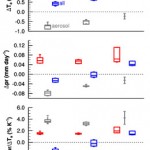Robust Response of Global Mean Precipitation to Anthropogenic Aerosol
Submitter: Marc Salzmann, Institute for Meteorology, Universität Leipzig
Area of Research: Atmospheric models
GEWEX Panel: Global Atmospheric System Studies (GASS) Panel
Journal Reference:
Salzmann, M., 2016. Global warming without global mean precipitation increase? Sci. Adv., 2, e1501572, doi: 10.1126/sciadv.1501572.
Science:
Climate models suggest that precipitation decreases by about 3-4% per kelvin for aerosol cooling. This is about twice as much as the precipitation increase of about 1.5 to 2% per kelvin for carbon dioxide warming, and helps to explain why thus far global mean precipitation has not increased markedly in spite of a net global warming caused by greenhouse gases.
Impact:
It is shown that the observed 20th century temperature increase can be used as a constraint on 20th century global mean precipitation simulated in climate models and a robust aerosol effect on precipitation is identified. This helps to more easily interpret historical changes of global mean precipitation and to reconcile climate model results with observations.
Summary:
Some regions have experienced an increase in precipitation while some other regions have seen a precipitation decrease. At the same time extreme rain events have become more frequent. Yet, some observations and also global climate models suggest that the global mean precipitation has neither increased nor decreased notably until recently. While greenhouse gas warming due to carbon dioxide has long been known to increase global mean precipitation in climate models by about 1.5 to 2% per kelvin warming, here it is shown that aerosol cooling in state-of-the art global climate models decreases precipitation by 3 to 4% per kelvin. Due to this robust effect of aerosol on precipitation, global mean precipitation has not increased notably in spite of a net global warming (based on global climate models that simulate a realistic 20th century warming). In the future, however, an increase of global mean precipitation close to the well known 1.5 to 2% per kelvin is expected as greenhouse gas warming is expected to become more important.
Link to the Original Research Publication or Website:
http://advances.sciencemag.org/content/2/6/e1501572



